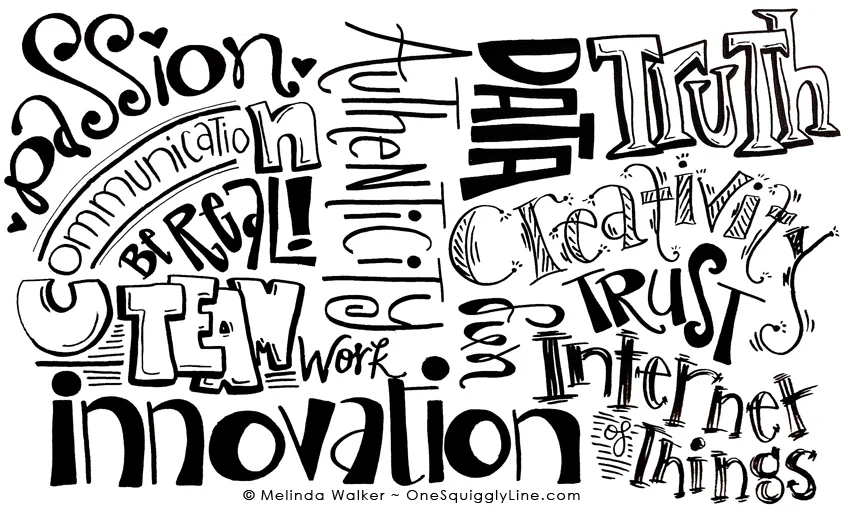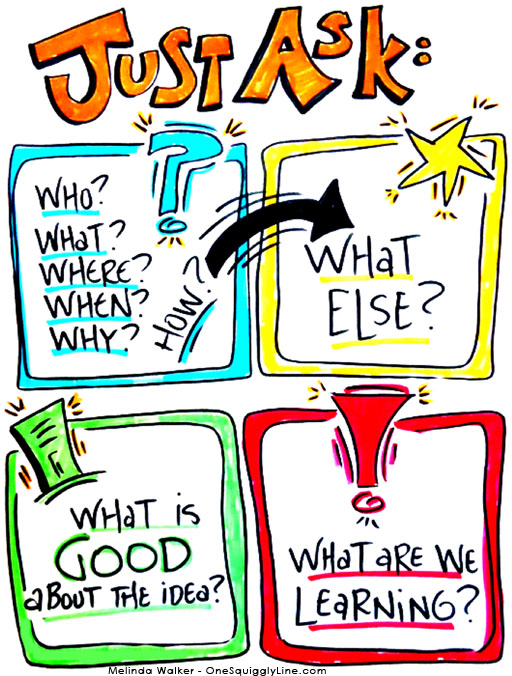The most common sizes for graphic recording are 40" x 60" or 4' x 8'. Flip chart sized paper or boards work better in some cases, though. Regardless the size, everyone benefits the most when the graphic recording is done where everyone can see. And displayed where folks can talk about the content after the fact.
Visual Thinking & Graphic Recording: Wedding Showers
Graphic recording is most common in business meetings, conferences, and other events. It's great for more personal occasions, too. Like weddings or wedding showers, as this drawing shows. Not only is this a great way to remember an important day, but the advice of friends and family, too!
Graphic Recording & Creative Lettering Design: Word Clouds
Word clouds are pretty common these days. They're usually computer generated with standard fonts. If you want your word cloud to really have impact, hand lettering is the way to go!
Hand-lettered word clouds can be created from print materials before or after and event. Or for a report or website, for example. They can also be created live as a different way of graphic recording. No pictures, only words. Words that are carefully drawn and designed to create an impact greater that just a list or something computer generated.
If you relate better to words than pictures, a hand-drawn word cloud can be a great bridge to reach those who are more picture oriented. Experience the impact yourself - contact me to create one for you!
Visual Thinking & Creative Lettering Design: Lowercase B
Drawing some letters is a great way to warm up your creative and visual thinking skills. That's what all these lowercase B's are about! I set a timer for a few minutes and drew as many different lowercase B's as I could in that time.
Setting a short time frame keeps you going. There's no time to evaluate what you just did. So you don't. You just keep coming up with ideas. There's plenty of time to evaluate things once you're done. The same is true whether you're drawing lowercase B's or thinking up ways to save the world.
Visual Thinking & Creativity: Use What You Have
When it comes to creativity and innovation, there's often a push for wild and crazy ideas. Wild and crazy ideas can be great and lead to great things, but they may also require wild and crazy resources. If resources are limited, the most creative, innovative, and practical solutions may simply be to use what you already have.
Visual thinking can help you take stock of the resources you have. And understand how they're currently being used. And how they all work together. Once you know what you have to work with, you can better figure out how to use those resources in new ways...even if you just want to build a better snowman!
Visual Thinking: Simple Meeting Template
To run successful meetings, it really helps to have a plan. Even really short meetings. That way, you're sure to get the most out of your time.
One great way to plan and document your meeting is with a visual template, like the one above. A visual template reminds you of what needs to be covered. Questions you want to be sure to ask. And even to setup the next meeting.
Noting key take-aways and feelings can help you pick up on insights and patterns you may otherwise miss. It also helps you think about things more broadly and deeply.
Visual Thinking & Creativity: Visualize!
Visual thinking and creativity have a lot in common. A whole lot. So much I did my master's project on the topic!
One key part of creativity and creative thinking is visualizing. That's really just another word for using and being aware of your imagination. Most people don't think about it much, but your imagination uses a lot of pictures. Just try to imagine a red rose without seeing a picture of it in your head...not gonna happen!
Getting those ideas and pictures out of your head is the first step towards creativity and innovation. As long as those ideas live only in your head, they're only a part of your imagination. They're dreams, not reality.
When you start putting those ideas down on paper, it helps you see them more clearly. And flesh out your idea more fully. Then you can better explain them to others. And they'll be more likely to understand them.
That's why visual thinking is not only powerful, but productive. Visual thinking leads to clarity. Clarity leads to confidence. And confidence is much more likely to lead to action.
Visual Thinking: Simple as 1-2-3!
One of the most powerful things about visual thinking is that it makes things simple. When things are simple, they're much easier to remember. And the more often you see something, the more likely you will be to remember it, too.
That's why simple posters are so powerful when working in person. And why simple online visuals are so powerful before and after events, or when you can't be face-to-face.
A super simple way to keep your visuals super simple is as easy as 1-2-3. Choose 1 central image. Use no more than 2 colors. And limit yourself to only 3 words. That's it!
That formula doesn't always work for everything, but it's a great place to start. Even if you have to sneak in an extra word or two, your visual will still be pretty simple.
Visual Thinking & Creativity: Keep it Posted!
When people look at things, they generally think about whatever they're looking at. So if you want to be sure people focus on certain things during your meeting or presentation, visuals can really help.
Posters are a great way to keep that info front and center in everyone's mind. Your posters don't need to be fancy. But they do need to be clear. Very clear. So clear people can get the info in a glance.
The poster above was created for a workshop I taught about thinking styles. It was used during a hands-on group activity to remind each group to try out all four thinking styles. The thinking styles are color coded, so it's easy to focus only on one square at a time. Yet, it gives a clear picture of the whole process. That way, people can move about the process at their own pace and see how they're connected.
Visual Thinking & Creativity: Use Things in New Ways
When it comes to innovation and creativity, it's common to think you need more. More ideas. More resources. More people. More money. More, more, more!
Truth is, more is not always better. In fact, the more you have, the more confusing things get. Striving for more can prevent you from taking a good look at what you already have. And putting it to good use.
When you pull apart what you do have and look at each part individually, it helps you see things in new ways. When you see things in new ways, you think in new ways. Use things in new ways. Do things in new ways. And that's what leads to creative and innovative breakthroughs.
Visual thinking can help you get a clearer picture of what you already have to work with. And think about how you might use whatever you have in new ways. Because there's always more than one way to build a snowman...or anything else!










